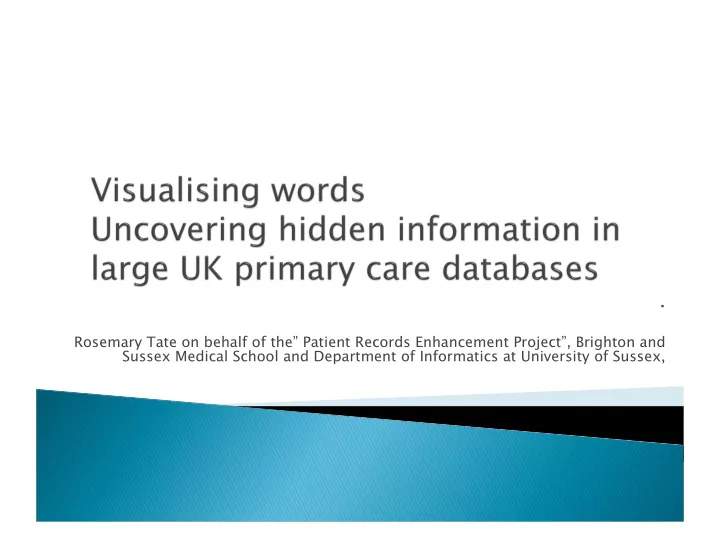

. Rosemary Tate on behalf of the” Patient Records Enhancement Project”, Brighton and Sussex Medical School and Department of Informatics at University of Sussex,
The role of General Practice in the UK The General Practice Research Database Why GPRD researchers need visualisation tools Example – ovarian cancer study Open questions
Have been recording electronically since the early 1980s Systems provide a huge amount of flexibility for recording Many different (Read) codes for the same thing May also use free text
Collections from 620 practices (~7% of UK practices) Contains over 12.5 million patients 5 million active (alive) patients (~8% popn.) Contains over 62 million patient-years of follow up Geographically representative of UK
Clinical records Read code for symptoms and /or diagnosis Test records Read code for test type +/- results Consultation data Information from each consultation stored in different record tables Referral records Read code Patient data for symptoms / Age, sex and (subsample diagnosis plus only) deprivation score specialty Prescription Practice data records Deprivation score, urban / rural location and NHS Code for prescribed region product 6
Track for early indicators of diagnoses Check data quality Develop models of patients’ journey through cancer Define definitions of ‘cases’ Annotate and edit the data; e.g., add causal links
Investigating symptoms and delay in diagnosis 344 patients with ovarian cancer Using data from the General Practice research database
Compared incidence of 5 most common symptoms in the year prior to diagnosis using 1. codes 2. free text (notes and letters) – mapped symptoms in text to “pseudo” Read codes Results: Incidence doubled for some symptoms when we used the free text Challenge – how to extract and present this extra information?
Typical patient record shown on a timeline
Icon indicating the presence of Free Text for event
LifeLines2 to show differences between free text and coded information
LifeLines2 to show differences between free text and coded information
How to present information at different levels of detail – show both the big picture and the individual records How to present information hidden in the free text? Provide for user interaction Accommodate for a range of user tasks
Aishath Ali 1 Lesley Axelrod 2 John Carroll 2 Jackie Cassell 1 Fliss Henwood 3 Rob Koeling 2 Donia Scott 2 Tim Williams 4 1 Division of Primary care, Brighton and Sussex Medical School 2 Dept of Informatics, University of Sussex 3 Applied Social Sciences, University of Brighton 4 General Practice Research Database, MHRA, London
Recommend
More recommend